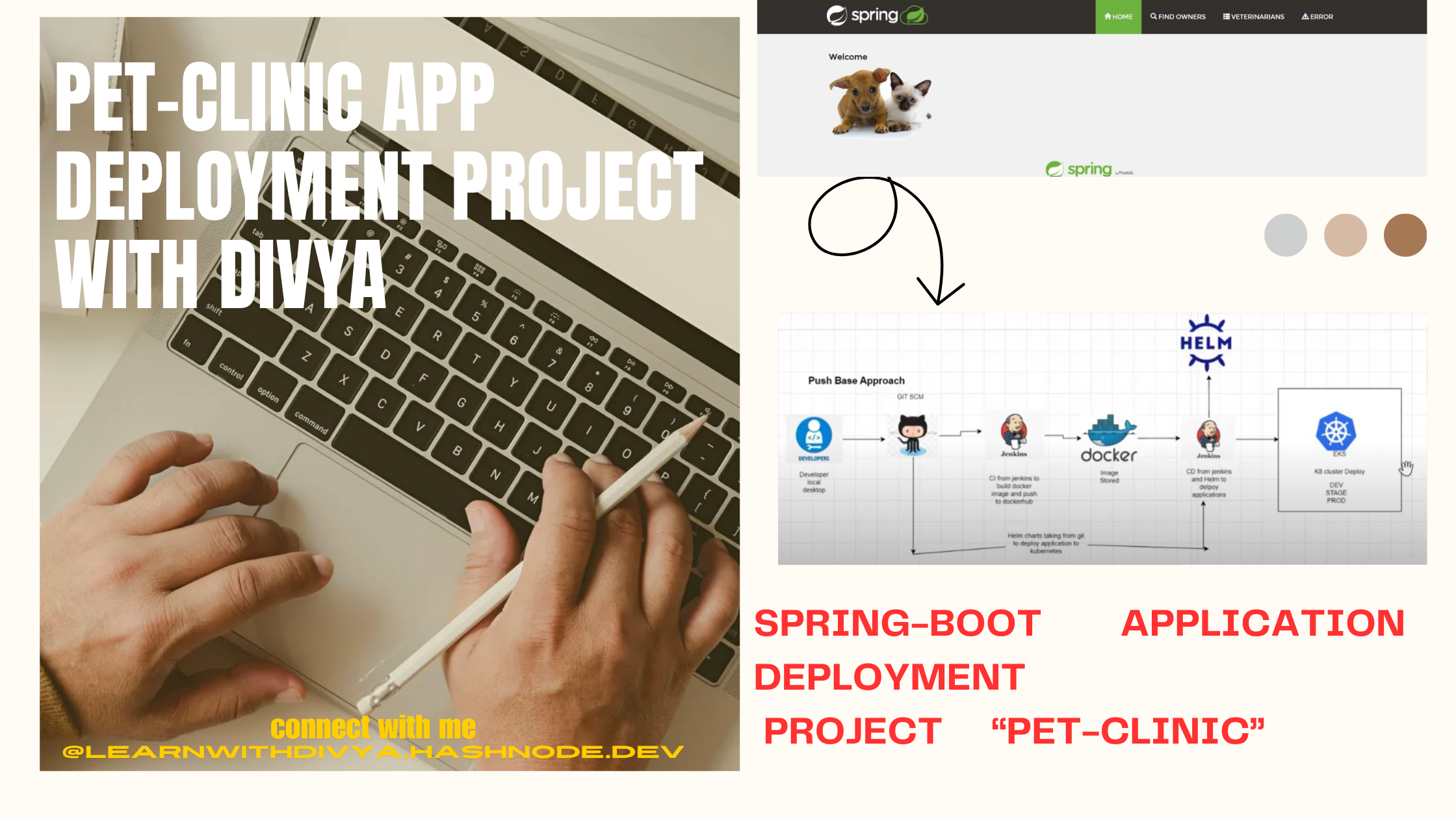Jenkins on Server Push Based Approach CICD
 Divya vasant satpute
Divya vasant satpute

What is CI/CD? 🛠️
Continuous Integration (CI) + Continuous Deployment (CD).
Automates software delivery process.
Server Push Based Approach 🔄
Code changes are automatically pushed to the server.
Reduces manual intervention and accelerates deployment.
Jenkins Overview 🐱👤
Popular open-source automation server.
Supports building, deploying, and automating projects.
How It Works 🖥️
Code Push: Developers push code to a version control system (e.g., Git) 🌐.
Webhook Trigger: A webhook notifies Jenkins of changes 🔔.
Build Process: Jenkins pulls the latest code and runs builds/tests 📊.
Deployment: Successful builds are automatically deployed to the server 🚢.
Benefits ✅
Faster Feedback: Immediate results on code changes.
Automated Testing: Ensures code quality through automated tests 🧪.
Consistent Releases: Reduces human error in deployments.
Scalability: Easily integrates with other tools and systems 🔗.
Common Tools Used 🔧
Version Control: Git
Notification Services: Slack, email alerts.
Containerization: Docker for consistent environments 🐳.
Use Cases 📌
Agile development teams looking for rapid iterations.
Organizations aiming for DevOps practices to improve collaboration.
Step by Step guide
Prerequisites
you must have your purchase domain and create hosted zone in Route 53 and replace this namespaces with your domain

Git clone
git clone https://github.com/divyasatpute/Jenkins.git
push this repo on your github
git push <your github repo URL >
Create Cluster using kubeadm script (step1)
For that you need to create 4 machine cluster
In this POC we need 1 master and 2 worker machine and Jenkins machine separately
On AWS Console
4 EC2 machine
ubuntu 20.04 AMI
volume 40GB (storage)
c5.xlarge Machine Type
after you have to connect all on gitbash
And update all cluster using following command :
sudo apt update -y
And set hostname for each node
sudo hostname Master
sudo hostname Worker1
sudo hostname Worker2
Come on root user
sudo -i
now on master node paste the following command (EKS Script ) Controlplane script
bash <(curl -s https://raw.githubusercontent.com/isakibshaikh1/Kubeadm/main/kubeadm/master.sh)
And on another on both Worker node paste following command (worker script)
bash <(curl -s https://raw.githubusercontent.com/isakibshaikh1/Kubeadm/main/kubeadm/worker.sh)

now your master node is ready take this token from master node and paste on worker node for join worker node to master
kubeadm join 172.31.46.89:6443 --token qanxgm.tmberexbyo3n0dpr --discovery-token-ca-cert-hash sha256:c2b6ac5e46556ed69c940fa8725eb37e6ccbeaa3f39117fc71a481a1798eac3c
as you can see node will be ready but worker node yet not ready state
Note that both nodes are NotReady. This is OK because we have not yet installed networking.

for that we have use some plugins Install a Network Plugin
Doc Ref : Installing Network Plugin Addons
Install Weave Net : Weave Net
kubectl apply -f https://github.com/weaveworks/weave/releases/download/v2.8.1/weave-daemonset-k8s.yaml

Installation of Jenkins (step 2)
### How to deploy Jenkins with Our custom domain and SSL ###
For install Jenkins we need to follow below shell script, i am using ubuntu 20.04 this script also work for ubuntu 22.04
vi jenkins.sh
Paste this script in Jenkins.sh
#! /bin/bash
sudo apt update
sudo apt install openjdk-11-jre -y
curl -fsSL https://pkg.jenkins.io/debian-stable/jenkins.io-2023.key | sudo tee \
/usr/share/keyrings/jenkins-keyring.asc > /dev/null
echo deb [signed-by=/usr/share/keyrings/jenkins-keyring.asc] \
https://pkg.jenkins.io/debian-stable binary/ | sudo tee \
/etc/apt/sources.list.d/jenkins.list > /dev/null
sudo apt-get update
sudo apt install -y maven
sudo apt-get install jenkins -y
sudo systemctl enable jenkins
sudo systemctl start jenkins
sudo systemctl status jenkins
Run script using this command
sh jenkins.sh
After that we need to check using Jenkins using ec2 instance id for example:- 34.203.34.186:8080 for checking purpose but our end goal its should not be run on this after configuring nginx reverse proxy will be remove port 8080 from ec2 instance security group and check , Here you can see our Jenkins up and running

Access your Jenkins Dashboard on browser now
Note: Make sure you enable 8080 port in Security Group Inbound Rules.
Get the initial administration password
$sudo cat /var/lib/jenkins/secrets/initialAdminPassword

Now your Jenkins started : Create Admin user

🎉Now , appreciate yourself you successfully deploy Jenkins on your machine 🎉
it is Look like this : Jenkins up and Running but this is not yet secured we have to add SSL for secure connection

Step-by-step guide to configure SSL on Jenkins using Let's Encrypt and NGINX reverse proxy (step 3)
Install NGINX on your server if it's not already installed. You can do this by running the following command:
#update repository first sudo apt-get update -y #install nginx by following commad sudo apt-get install nginx -y #check nginx status sudo systemctl status nginx
Create a new server block configuration file for Jenkins. You can do this by creating a new file in the /etc/nginx/sites-available/ directory. For example:
sudo vi /etc/nginx/sites-available/jenkinsAdd the following content to the file: Note: Replace jenkins.example.com with your Jenkins domain name.
server { listen 80; server_name jenkins.learnwithdivya.online; location / { proxy_pass http://localhost:8080; proxy_set_header Host $host; proxy_set_header X-Real-IP $remote_addr; proxy_set_header X-Forwarded-For $proxy_add_x_forwarded_for; proxy_set_header X-Forwarded-Proto $scheme; } }Create a symbolic link to the server block configuration file in the /etc/nginx/sites-enabled/ directory:
sudo ln -s /etc/nginx/sites-available/jenkins /etc/nginx/sites-enabled/
Note: you can see /etc/nginx/sites-available/jenkins on this path the file - represented simple file ( $sudo ls -lrt /etc/nginx/sites-available/jenkins)
after running above command its create shortcut because by default Jenkins look this file on /etc/nginx/sites-enabled location (ls -lrt /etc/nginx/sites-enabled)
Test the NGINX configuration and restart the NGINX service:
sudo nginx -t
#restart the nginx server
sudo systemctl restart nginx
Install Certbot, the Let's Encrypt client, by running the following commands:
sudo apt-get update -y sudo apt-get install certbot python3-certbot-nginx -yObtain an SSL certificate for your Jenkins domain name using Certbot:
sudo certbot --nginx -d jenkins.learnwithdivya.online
#Note:Replace jenkins.example.com with your Jenkins domain name.
- After running above you can found error like this :

For resolve this issue you need to create A name record on your Route53 service
Go to route53 --> click on hosted zone --> click on your domain name ---> create on record , once it will be insync then you can try again above command

🎉 Congratulations! 🎉
You've put in hard work, dedication, and perseverance to reach this milestone!

Now your Jenkins runs in secure with SSL certificate in secure site

It means without using LLB we are use nginx as a reverse proxy : if you are trying to click http:// still it will be redirect to https://
Sounds interesting, right?
Now move to next
create webhook on Github(step 4)
Click on repo settings --->
click on webhook ---->
Add new Webhook --->
in Playload URL configure your Jenkins URL followed by github-webhook and content type json
click on ADD webhook

Our Webhooks are ready

🐳Docker Install on Jenkins machine🐳
sudo apt install docker.io -y
Give permission to socket
sudo usermod -aG docker $USER
sudo chown $USER:docker /var/run/docker.sock
change ownership
sudo chown jenkins:docker /var/run/docker.sock
Go to docker hub account generate token
now on your Jenkins machine click on manage Jenkins --> click on Credentials --->
system ---> global Credentials
ADD your docker token as a password
ADD (ID) which is you given in your pipeline

Plugins Installation
Manage Jenkins --> plugins ---> available plugins ---->
docker
docker Pipeline
docker commons
docker -build-steps
docker slave
install it
Installation of Helm
Helm Install on Jenkins Machine and Master Node
curl -fsSL -o get_helm.sh https://raw.githubusercontent.com/helm/helm/main/scripts/get-helm-3
chmod 700 get_helm.sh
./get_helm.sh
configuration on master node
change directory
cd .kube/
copy config file in /home/ubuntu
change directory
cd /home/ubuntu/
change ownership
sudo chown ubuntu:ubuntu config
break connection come into your local machine download folder
exit

Now fire this command on local (copy file from remote to local)
scp -i divya.pem ubuntu@43.204.109.240:/home/ubuntu/config .


New to go to Jenkins dashboard
click on manage Jenkins
click on Credencials
select as a secrete file
and upload config file

Go to Jenkins dashboard
click on manage Jenkins
click on available plugins
- install it
### How to Set Up the Jenkins + GitHub Integration ###
NOW LAST STEP TO ACHIEVE THE THINGS
create Jenkins pipeline
pipeline {
agent any
stages {
stage('Build Maven') {
steps {
sh 'pwd'
sh 'mvn clean install package'
}
}
stage ('Copy Artifacts') {
steps {
sh 'pwd'
sh 'cp -r target/*.jar docker'
}
}
stage('Unit Tests') {
steps {
sh 'mvn test'
}
}
stage('Build Docker Image'){
steps{
script {
def customImage = docker.build("iamsakib/petclinic:${env.BUILD_NUMBER}", "./docker")
docker.withRegistry('https://registry.hub.docker.com', 'dockerhub') {
customImage.push()
}
}
}
}
stage('Build on kubernetes'){
steps {
withKubeConfig([credentialsId: 'kubeconfig']) {
sh 'pwd'
sh 'cp -R helm/* .'
sh 'ls -ltrh'
sh 'pwd'
sh '/usr/local/bin/helm upgrade --install petclinic-app petclinic --set image.repository=iamsakib/petclinic --set image.tag=${BUILD_NUMBER}'
}
}
}
}
}
#replace yours id
Deployment of Application
Go to Jenkins dashboard
click on new item
give name to your project
select pipeline
select GitHub hook trigger for GITScm polling
select pipeline script with SCM
SCM =git and configure GIT URL and branch
script path should be jenkinsfile (jenkinsfile should be available on your git repo)
save and apply
Access your application <worker_node_Pliblic_IP:32740\>
And boommmmmmmmmmmmm
🌟 Way to Go! 🌟
You've done it—what an incredible achievement! This moment is a testament to your effort, resilience, and talent. You faced the challenge head-on and came out on top, and now it's time to celebrate that success.
Remember, this is proof of what you're capable of. Keep pushing forward, and don't forget to enjoy every victory along the way. You've earned it—congratulations!
✅Test Results ✅





Subscribe to my newsletter
Read articles from Divya vasant satpute directly inside your inbox. Subscribe to the newsletter, and don't miss out.
Written by

Divya vasant satpute
Divya vasant satpute
, I'm a seasoned DevOps engineer 🛠️ with a knack for optimizing software development lifecycles and infrastructure operations. 💡 Specializing in cutting-edge DevOps practices and proficient in tools like Docker, Kubernetes, Ansible, and more, I'm committed to driving digital transformation and empowering teams to deliver high-quality software with speed and confidence. 💻

